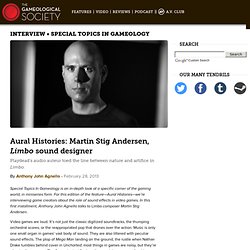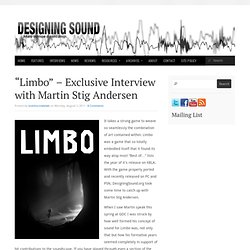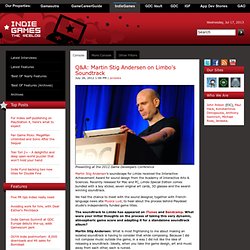

Audio Design Deep Dive: Scoring Wolfenstein. This Audio Design Deep Dive is a fresh, game audio-focused spin on Gamasutra's popular Game Design Deep Dive series, which aims to shed light on specific features or mechanics within a video game in order to show how seemingly simple, fundamental design decisions aren't really that simple at all.

If you enjoy this sort of focused look at the nuts and bolts of game development, check out earlier installments on design of the Clockwork Mansion level in Dishonored 2, creating a new language for Planet Coaster, and maintaining tension in Nex Machina. Also, dig into our ever-growing Deep Dive archive for developer-minded features on everything from Amnesia's sanity meter to the Invasion of Privacy missions in Watch Dogs 2. Who: Martin Stig Andersen, sound designer and composer I’m Martin Stig Andersen and I worked as a composer on Wolfenstein II: The New Colossus. Previously, I worked as a composer and sound designer on LIMBO and INSIDE. Heard About: How Playdead used a real human skull for Inside's audio. John Broomhall talks with Limbo’s audio creator Martin Stig Andersen How is the audio development for Inside characterised by a blurring of sound design and implementation?

One thing is to create great sounds. Another is to make them come alive in the game. Creating Inside’s character sounds often required an iterative process where we’d first go and make sound recordings, start developing an implementation strategy for them – and then, based on our learnings, go back and re-record in a way that would fit the implementation strategy. The more the sounds are shaped by various game parameters, the more the game comes alive. On a global level, a lot went into implementing custom sound transitions between death and respawn to maintain immersion through unloading/reloading. There’s an intangible dynamic between real-world and game-world time. However, if I quit the game and get back to it after a few days I probably do want to hear them again.
Aural Histories: Martin Stig Andersen, Limbo sound designer. Special Topics In Gameology is an in-depth look at a specific corner of the gaming world, in miniseries form.

For this edition of the feature—Aural Histories—we’re interviewing game creators about the role of sound effects in video games. In this first installment, Anthony John Agnello talks to Limbo composer Martin Stig Andersen. Video games are loud. It’s not just the classic digitized soundtracks, the thumping orchestral scores, or the reappropriated pop that drones over the action. Music is only one small organ in games’ vast body of sound. The Gameological Society: What is the role of sound in video games? You can make sounds for all kinds of things, but in the end, what is most important is to communicate the game design. Aural Histories: Martin Stig Andersen, Limbo sound designer. Www.audiokinetic.com/download/documents/customer_profiles/Audiokinetic_Customer_Profile_Playdead_July2010.pdf. _Customer_Profile_Playdead_July2010.pdf. “Limbo” – Exclusive Interview with Martin Stig Andersen.
It takes a strong game to weave so seamlessly the combination of art contained within.

Limbo was a game that so totally embodied itself that it found its way atop most “Best of…” lists the year of it’s release on XBLA. With the game properly ported and recently released on PC and PSN, DesigningSound.org took some time to catch up with Martin Stig Andersen. When I saw Martin speak this spring at GDC I was struck by how well formed his concept of sound for Limbo was, not only that but how his formative years seemed completely in support of hit contributions to the soundscape. If you have played through even a section of the game you will know that this could be no small feat, as it’s not every sound designer that could inexorably link the flickering black and white images to abstract impressions of sound.
This is a story that follows a complete trajectory. Read on for further insight… DK: How did your education prepare you for interactive media? Interview with Limbo composer, Martin Stig Andersen. Shhh, ¿can you hear it?

It’s your own soul. With Playdead’s Limbo we begin a mysterious trip into the inside of everyone, embodied in the history of the child who wakes up at the door of hell. The music, by Martin Stig Andersen, is about one of the most trascendental freedom, perhaps the last: Feeling. With the soundtrack of Limbo we go into the realm of the unexplored, the sound seems to emerge from the depths of human beings. We talked with Martin Stig Andersen about his work in Limbo, whose soundtrack was released in early July 2011 on iTunes and Bandcamp. As a composer, what is your main influences?
Having a background in classical compositions I think some of my main influences are associated with French music tradition, from impressionism to spectral compositions but mostly, of course, electroacoustic and acousmatic music. Thanks for that. Music is a great means for creating ambiguity, and in Limbo I did that by associating haunting sounds to gruesome actions for example. The Weblog Q&A: Martin Stig Andersen on Limbo's Soundtrack. Presenting at the 2012 Game Developers Conference Martin Stig Andersen's soundscape for Limbo received the Interactive Achievement Award for sound design from the Academy of Interactive Arts & Sciences.

Recently released for Mac and PC, Limbo Special Edition comes bundled with a boy sticker, seven original art cards, 3D glasses and the award-winning soundtrack. We had the chance to meet with the sound designer, together with French-language news site Musica Ludi, to hear about the process behind Playdead studio's independently funded game titles. The soundtrack to Limbo has appeared on iTunes and Bandcamp.